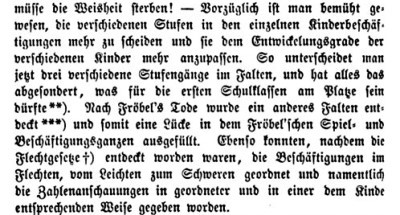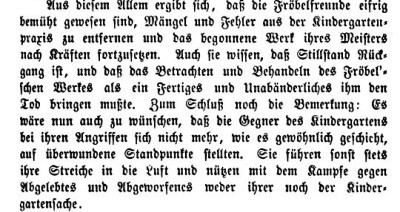| The Public Paperfolding History Project
Last updated 2/11/2025 x |
|||||||
| Der Kindergarten in seinen Wesen dargestellt by August Koehler, 1868 | |||||||
'Der Kindergarten in seinen Wesen dargestellt' (The Kindergarten in its essence) by August Koehler was published by Hermann Bohlau in Weimer in 1868. Inter alia the work contains a list of gifts (including occupations), several interesting passages about the historical development of paperfolding / kindergarten practice and a Bibliography of publications about the kindergarten. A second revised edition was issued in 1874 (see here ) but, apart from the mention of some new publications in the Bibliography, the information relating to the paperfolding occupations is unchanged. **********
Roughly translated this passage says: 'Froebel made no changes to the Folding Sheet, and the forms are the same as those already made with this paper before Froebel. But he discovered the way in which these forms can develop through gradual progress from one fold to the next.' **********
Roughly translated this passage says: 'Three different stages in folding are distinguished, and everything that should be suitable for the first school grade has been separated out. After Froebel's death another folding method was discovered *** and thus a gap in Froebel's playy and activity system was filled.' (This is a clear reference to the author's discovery of what I call Koehler's Groundform which is made by folding in the opposite sets of edges of a square in turn and thus produces a crease pattern made of squares rather than triangles.) The passage continues: 'Likewise, after the braiding techniques were discovered, braiding techniques could be arranged from easy to difficult ...' which clearly suggests that these braiding techniques were both new at that time and unknown to Froebel. **********
Roughly translated this passage says, inter alia: 'From all this it follows that Froebel's friends have been diligently striving to eliminate shortcomings and errors from kindergarten practice and to continue their master's work to the best of their ability. They know that stagnation is regression and that viewing and treating Froebel's work as something finished and unalterable is bound to bring about its demise.' ********** A full copy of this work can be accessed online here. **********
********** Analysis This work contains a list of Froebel's gifts and occupations, setting each in its historical concept. The list is introduced by the following words, roughly translated: 'One of the most common assumptions is that Froebel invented new educational materials, and that these were now to be forcibly imposed on the children in his kindergarten. This, however, is a blatant error. Some of the gifts and occupations used in the kindergarten are ancient, so ancient that the time of their introduction in the world of children can no longer be determined. Most of the others have served the children of educated societies for their intellectual and physical development for centuries, if not for millenia. Let us go through them one by one.' (This should not be taken as criticism of Froebel by the author but as a defence of his method of adapting existing games and occupations for a new pedagogical purpose.)
********** Two of the paperfolding occupations appear in this list: Das Faltblatt ie Falten
Roughly translated this passage says: '11th Gift: The Folded Sheet. A small piece of paper that, similar to napkins at banquet tables, can be folded and used to make not only geometric shapes but also so-called Schonnheitsformen and Lebensformen. Many mothers, maids and nannies already knew how to use the folded sheet, from which one can form a box, a hat, a bellows, a boat, a raven etc., in the previous century. It is a children's activity that has been inherited by all civilsed peoples.' The Raben is presumably The Cocotte / Pajarita and the Blasebalg The Bellows. There are options for the identification of the box, hat and boat. (Note that, at this date, the known designs for hats were all from oblongs rather than the square.) ********** Das Ausschneideblatt ie Ausschneiden und Aufkleben
Roughly translated this passage says: '12th Gift: The Cutting Sheet is also an old nursery activity. The child makes its first attempts with scissors. The sections are pasted into various shapes. Cutting and pasting are activities loved by all children, and in which their drive to learn is richly nourished.' ********** Note that, rather strangely, the author's list of occupations does not include Verschnuren (or Schuren). However, this may be an oversight as paper strips are mentioned elsewhere and thus must have had some purpose within the gifts at that time:
Roughly translated this passage says, inter alia: 'Their vigilance is also directed towards ensuring that no child takes even a single cube or strip of paper from another'. ********** |
|||||||







